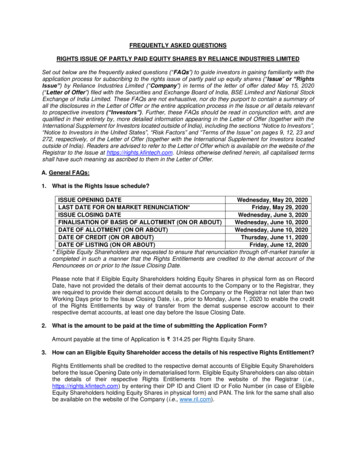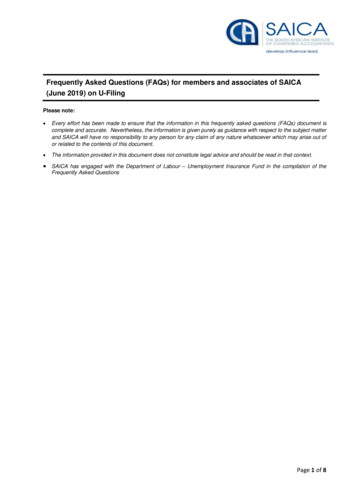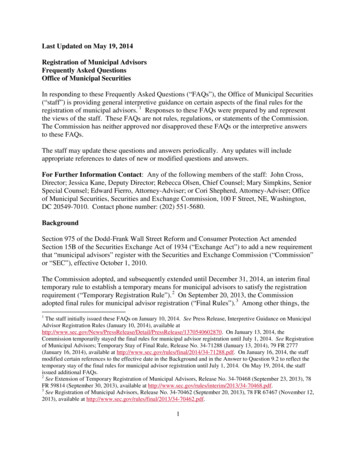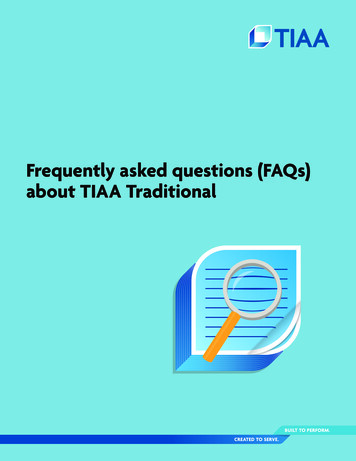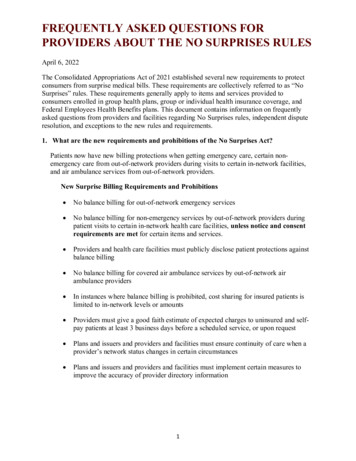
Transcription
FREQUENTLY ASKED QUESTIONS FORPROVIDERS ABOUT THE NO SURPRISES RULESApril 6, 2022The Consolidated Appropriations Act of 2021 established several new requirements to protectconsumers from surprise medical bills. These requirements are collectively referred to as “NoSurprises” rules. These requirements generally apply to items and services provided toconsumers enrolled in group health plans, group or individual health insurance coverage, andFederal Employees Health Benefits plans. This document contains information on frequentlyasked questions from providers and facilities regarding No Surprises rules, independent disputeresolution, and exceptions to the new rules and requirements.1. What are the new requirements and prohibitions of the No Surprises Act?Patients now have new billing protections when getting emergency care, certain nonemergency care from out-of-network providers during visits to certain in-network facilities,and air ambulance services from out-of-network providers.New Surprise Billing Requirements and Prohibitions No balance billing for out-of-network emergency services No balance billing for non-emergency services by out-of-network providers duringpatient visits to certain in-network health care facilities, unless notice and consentrequirements are met for certain items and services. Providers and health care facilities must publicly disclose patient protections againstbalance billing No balance billing for covered air ambulance services by out-of-network airambulance providers In instances where balance billing is prohibited, cost sharing for insured patients islimited to in-network levels or amounts Providers must give a good faith estimate of expected charges to uninsured and selfpay patients at least 3 business days before a scheduled service, or upon request Plans and issuers and providers and facilities must ensure continuity of care when aprovider’s network status changes in certain circumstances Plans and issuers and providers and facilities must implement certain measures toimprove the accuracy of provider directory information1
2. I want more information on provider and facility requirements. Are there anyexceptions?Requirement: No balance billing for out-of-network emergency servicesRequirement Details Exceptions to RequirementOut-of-network providers and out-ofnetwork emergency facilities cannot billor hold liable participants, beneficiaries,or enrollees who received emergencyservices for a payment amount greaterthan the in-network cost-sharingrequirement. For these protections to apply,emergency services must be received ata hospital or an independent freestandingemergency department. The patient must be enrolled in a grouphealth plan or group or individual healthinsurance coverage. For this purpose, aFederal Employees Health Benefits planis included as a group health plan. Cost-sharing is generally based on themedian of contracted rates payable to innetwork providers or in-networkfacilities. Certain post-stabilization services areconsidered emergency services, and aretherefore subject to this prohibition,unless notice and consent and certainother requirements are met (see nextcolumn).2Out-of-network providers and out-ofnetwork emergency facilities may balancebill for post-stabilization services only if allof the following conditions have been met:The attending emergency physician ortreating provider determines that theparticipant, beneficiary, or enrollee: Can travel using non-medical or nonemergency medical transportation to anavailable in-network provider or facilitylocated within a reasonable traveldistance, taking into account theindividual’s medical condition; and Is in a condition to receive notice andprovide informed consent; The out-of-network provider or out-ofnetwork emergency facility provides theparticipant, beneficiary, or enrollee witha written notice including certaininformation during a specific timeframe(as provided in regulations andguidance) and obtains consent to waivesurprise billing protections; and The provider or facility satisfies anyadditional state law requirements.
Requirement: No balance billing for certain non-emergency services by out-of-networkproviders during patient visits to in-network health care facilities, unless notice and consentrequirements are met. Review and download Standard Notice and Consent Documents.Requirement Details Exceptions to RequirementThe notice and consent exception does notapply to the following list of ancillaryservices, meaning a provider is alwaysprohibited from balance billing for theseservices:Out-of-network providers cannot bill orhold liable participants, beneficiaries, orenrollees in group health plans or group orindividual health insurance coverage whoreceived covered non-emergency servicesat an in-network health care facility for anamount greater than the in-network costsharing requirement for those services,unless notice and consent requirementsare met.Cost-sharing is generally based on themedian of amounts that would have beencharged by in-network providers or innetwork facilities.For purposes of these protections, health carefacilities include: hospitals, hospitaloutpatient departments, critical accesshospitals, and ambulatory surgical centers.These protections do not apply to other typesof health care facilities, such as urgent carecenters.3 Items and services related toemergency medicine, anesthesiology,pathology, radiology, and neonatology Items and services provided byassistant surgeons, hospitalists, andintensivists Diagnostic services, includingradiology and laboratory services Items and services provided by an outof-network provider if there is no innetwork provider who can provide theitem or service at the facility.
Requirement: Disclosure of patient protections against balance billing. Review and downloadthe Model Disclosure Notice.Requirement Details Exceptions to RequirementA provider isn’t required to make disclosuresif the provider doesn’t furnish items orservices at a health care facility at which thebalance billing protections apply, or inconnection with a visit to such a health carefacility.A provider or facility must disclose to anyparticipant, beneficiary, or enrollee in agroup health plan or group or individualhealth insurance coverage to whom theprovider or facility furnishes items andservices information regarding federal andstate (if applicable) balance billingprotections and how to report violations.A provider is not required to make thedisclosure to individuals to whom theprovider furnishes items or services, if suchitems and services are not furnished inconnection with a visit at a health carefacility.Providers or facilities must post thisinformation prominently at the location ofthe facility if the location is publiclyaccessible, post it on a public website (ifapplicable), and provide it to theparticipant, beneficiary or enrollee nolater than the date and time on which theprovider or facility requests payment fromthe individual or, with respect to anindividual from whom the provider orfacility does not request payment, no laterthan the date on which the provider orfacility submits a claim to the grouphealth plan or health insurance issuer.A provider isn’t required to make thedisclosure to individuals if there is a writtenagreement where the facility agrees to makethe disclosure instead of the provider.4
Requirement: No balance billing for air ambulance services by out-of-network providers of airambulance servicesRequirement DetailsExceptions to Requirement None.Out-of-network providers of airambulance services cannot bill or holdliable participants, beneficiaries, orenrollees in group health plans or group orindividual health insurance coverage whoreceived covered air ambulance servicesfor an amount greater than the in-networkcost-sharing requirement for thoseservices. The cost-sharing requirement is generallybased on the lesser of the median ofcontracted rates payable to in-networkproviders of air ambulance services or thebilled amount for the services.5
Requirement: Providing a good faith estimate in advance of scheduled services, or uponrequest, to an uninsured or self-pay individual.Requirement Details Exceptions to RequirementWhen a health care provider or facilityschedules an item or service, it mustinquire if the individual who schedules anitem or service is enrolled in a grouphealth plan, group or individual healthinsurance coverage offered by a healthinsurance issuer, a federal health careprogram, or a Federal Employees HealthBenefits plan. If so, the provider orfacility must inquire if the individual isseeking to have their claims for the itemor service submitted to the individual’splan or coverage. If the patient has no such plan orcoverage, or doesn’t intend to submit aclaim to the plan or coverage, the provideror facility must provide notification to thepatient (in clear and understandablelanguage) of the good faith estimate of theexpected charges, expected service, anddiagnostic codes of scheduled services. The good faith estimate must includeexpected charges for the items or servicesthat are reasonably expected to beprovided in conjunction with the primaryitem or service, including items orservices that may be provided by otherproviders and facilities. For more information regarding the goodfaith estimate for uninsured (or self-pay)individuals, see Guidance on Good FaithEstimates and the Patient-ProviderDispute Resolution (PPDR) Process forProviders and Facilities If the patient is enrolled in such plan orcoverage, and intends to have a claimsubmitted for the scheduled items orservice, the provider or facility mustsubmit a good faith estimate to the plan orissuer, which in turn must send anadvance explanation of benefits to thepatient.6 From January 1, 2022 through December31, 2022, the Department of Health &Human Services (HHS) will exercise itsenforcement discretion in situations wherea good faith estimate provided to anuninsured (or self-pay) individual doesn’tinclude expected charges from otherproviders and facilities that are involvedin the individual’s care. Until rulemaking is issued regarding therequirement to provide a good faithestimate to an individual’s plan orcoverage, HHS will defer enforcement ofthe requirement that providers andfacilities provide good faith estimateinformation for individuals enrolled in aplan or coverage and seeking to submit aclaim for scheduled items or services totheir plan or coverage.
Requirement: Continuity of care when a provider’s network status changesRequirement Details Exceptions to RequirementNone.When the contractual relationshipbetween a plan or issuer and a provider orfacility ends and results in a change in theprovider or facility’s network status, if thehealth care provider or facility has acontinuing care patient, they must: Accept payment from the plan orissuer (and cost-sharing paymentsfrom the individual) for the course oftreatment of a continuing care patientat the previously agreed-uponpayment amount for up to 90 daysafter the date the patient was notifiedof the change in the provider’snetwork status. Continue to adhere to all policies,procedures, and quality standardsimposed by the plan or issuer for suchitems or services as if the contractwere still in place.7
Requirement: Implement measures to improve the accuracy of provider directoriesRequirement Details Exceptions to RequirementNone.Any health care provider or health carefacility that has or has had a contractualrelationship with a plan or issuer toprovide items or services under thecoverage must submit provider directoryinformation to the plan or issuer, at aminimum: At the beginning of the networkagreement with the plan or issuer, At the time of termination of thenetwork agreement with the plan orissuer, When there are material changes to thecontent of the provider directoryinformation of the provider or facility, Upon request by the plan or issuer, and At any other time determinedappropriate by the provider, facility, orHHS Any health care provider or health carefacility that has or has had acontractual relationship with a plan orissuer to provide items or servicesunder the plan or insurance coveragemust: Reimburse participants,beneficiaries, or enrollees who inreliance on an incorrect providerdirectory, paid a provider bill inexcess of the in-network costsharing amount. Reimbursementmust be for the full amount paid inexcess of the in-network costsharing amount, plus interest.8
3. Do No Surprises protections apply to patients in all types of insurance? Generally, the No Surprises protections apply to individuals enrolled in a health careplan, through an employer (whether self-funded or insured, including coverage offered byfederal, state, or local governments, or a multiemployer plan), or through the federalMarketplaces, state-based Marketplaces, or directly through an individual market healthinsurance issuer. The rules don’t apply to people with coverage through programs like Medicare,Medicaid, Indian Health Services, Veterans Affairs Health Care, or TRICARE. Each ofthese programs already has other protections against surprise medical bills. Theprotections also don’t apply to individuals enrolled in short-term limited durationinsurance, excepted benefits (such as stand-alone dental or vision-only coverage), orretiree-only plans. Uninsured and self-pay individuals are also entitled to a good faith estimate, upon requestor scheduling of an item or service, through the No Surprises billing protections.4. Where can I send questions I have about these new provider and facility requirements?You can send any questions about the provider requirements toprovider enforcement@cms.hhs.gov.5. What types of providers do the No Surprises requirements apply to?When assessing whether a No Surprises requirement applies to a particular provider, it isimportant to look at how the provider practices, rather than the provider’s specialty type, license,or certification. The rules apply broadly to any physician or other health care provider who isacting within the scope of practice of that provider’s license or certification under applicablestate law. However, some providers may not practice in a setting or manner that triggers certainrequirements. For example, a provider who never furnishes services in connection with a visit toa health care facility or emergency facility wouldn’t furnish items or services that fall within thebalance billing protections. However, that same provider would, for example, need to provide agood faith estimate of expected charges to uninsured or self-pay individuals, when applicable,and comply with the continuity of care and provider directory requirements.6. Providers and facilities are generally required to provide participants, beneficiaries, andenrollees with a written disclosure about their balance billing protections. Does the patientneed to sign an acknowledgement that the patient has received the new disclosure noticeregarding patient protections against surprise billing disclosure?No. Under the No Surprises Act, health care providers and facilities must make publiclyavailable, post on a public website of the provider or facility (if applicable), and provide a onepage notice that includes information in clear and understandable language regarding patientprotections against surprise billing. Patients don’t need to sign to acknowledge that they havereceived the disclosure notice regarding patient protections against surprise billing. Review anddownload the model disclosure notice for patient protections against surprise billing, whichproviders and facilities may use.Note, providers and facilities may also provide patients with a notice and consent form if they areasking the patient to waive their balance billing protections. This is a different notice, anddifferent requirements apply to the use of this notice.9
7. The No Surprises rules allow patients to give consent to waive surprise billing protections incertain circumstances. Is a patient required to sign the notice and consent form in order towaive their protections?Under the No Surprises Act, if a provider or facility plans to balance bill a patient incircumstances in which that would otherwise be prohibited, the out-of-network provider or anout-of-network emergency facility must provide the patient (or an authorized representative) witha notice detailing the patient’s protections and providing information about the potential costs ifthe patient waives their surprise billing protections.A patient (or an authorized representative) isn’t required to, nor should the patient (or theirauthorized representative), sign the consent form unless the patient is willing to waive theseprotections and understands or agrees they will be paying out of pocket for balance bills on outof-network services. However, the patient’s (or an authorized representative’s) signature(physically or digitally) on the consent form is necessary for a waiver of the balance billingprotections to be effective. The standard notice and consent forms, which providers and facilitiesmust use in instances where the provider or facility seeks to balance bill the patient, must beprovided in accordance with the regulations and guidance issued by HHS. Providers andfacilities must retain signed documents for at least 7 years.Note that notice and consent is only allowed for post-stabilization services, if certain conditionsare met, and for certain non-emergency services. For non-emergency care (not post-stabilizationservices) provided by out-of-network providers related to a visit to an in-network facility,surprise billing prohibitions always apply to ancillary services including diagnostic services likeradiology and laboratory services, anesthesiology, pathology, and neonatology, regardless ofwhether provided by a physician or nonphysician practitioner, and a patient is not permitted towaive surprise billing protections for these services. Thus, in surprise billing situations, providersare not allowed to seek notice and consent for these services.8. When using the standard notice and consent Documents, can a provider or facilitycomplete the form by listing a physician or provider group instead of an individualphysician or provider’s name? For example, could the form list XYZ Physician Group ifthe individual scheduling the visit doesn’t know who will see the patient on the day of thevisit?The notice and consent form must explicitly identify the individual provider who is expected toprovide a given service; listing a provider group is not permitted.9. If a patient is having elective services (that is, non-emergency services) and the facility isout-of-network, may the facility, or the provider balance bill the patient?The federal balance billing prohibitions don’t apply to non-emergency services provided by outof-network providers during patient visits to out-of-network facilities. In this setting, the providerdoes not need to obtain the patient’s consent to bill them directly, or balance bill them.10. How many types of fees are there for the Federal Independent Dispute Resolution (IDR)process?There are 2 fees for independent dispute resolution:1. The administrative fee for use of the process2. The certified IDR entity fee, which is payment for review10
What is the IDR administrative fee? How much is it? Each party is required to pay an administrative fee per single or batched determination. Theadministrative fee is intended to cover the cost to the Federal government of the FederalIDR Process. For calendar year 2022, the administrative fee due from each party (i.e., theprovider or facility, and the insurance company or plan) for participating in the Federal IDRprocess is 50.11. What is the certified IDR entity fee?Each party (i.e., the provider or facility and the insurance company or plan) must pay the entirecertified IDR entity fee. The certified IDR entity fees are due when each party submits theiroffer. Following the payment determination, generally, the certified IDR entity fee paid by theprevailing party will be refunded to that party; in some cases, the refund of the fee may be split.For more information, see cess-NSA.pdf.12. How much is the certified IDR entity fee?Single DeterminationFor calendar year 2022, certified IDR entities must charge a fixed certified IDR entity fee forsingle determinations within the range of 200- 500, unless the certified IDR entity has receivedapproval from the Departments to charge a fee outside that range.Batched DeterminationA batched determination involves multiple qualified IDR items or services that are consideredjointly as part of one payment determination by a certified IDR entity for purposes of the FederalIDR process. The administrative fees will not be refunded, even if the parties reach an agreementbefore the certified IDR entity makes a determination. If a certified IDR entity chooses to chargea different fixed certified IDR entity fee for batched determinations, for calendar year 2022, thatfee must be within the range of 268- 670, unless the certified IDR entity has received approvalfrom the Departments to charge a fee outside that range.13. I am a provider or facility and have questions about the IDR Administrative Fee and/or theCertified IDR Entity Fees that will be charged.For further questions about the Federal IDR process or fee guidance, please contact us atFederalIDRQuestions@cms.hhs.gov.This communication was printed, published, or produced and disseminated at U.S. taxpayerexpense. The information provided in this guidance is intended only to be a general informalsummary of technical legal standards. It is not intended to take the place of the statutes,regulations, or formal policy guidance upon which it is based. This guidance summarizes currentpolicy and operations as of the date it was presented. We encourage readers to refer to theapplicable statutes, regulations, and other interpretive materials for complete and currentinformation.11
1 . FREQUENTLY ASKED QUESTIONS FOR PROVIDERS ABOUT THE NO SURPRISES RULES . April 6, 2022 The Consolidated Appropriations Act of 2021 established several new requirements to protect







